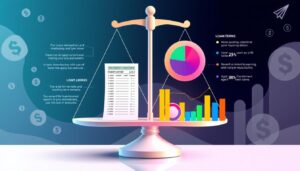Ever wondered why the interest rate on a loan isn’t the whole story? The total cost of a loan is more than just the principal and interest. It includes other expenses that can greatly affect how affordable a loan is.
This guide will help you understand the total cost of a loan. It will give you a detailed breakdown of loan costs for better financial planning. Knowing these costs is key to avoid borrowing too much and to make sure the loan fits your budget.
Understanding the Total Cost of a Loan
The Total Cost of a Loan is more than just the amount you borrow. It also includes interest over time and extra fees. Knowing these parts helps borrowers understand the full cost of their loan.
Extra costs like origination fees and closing costs can change your financial situation. It’s important to know these costs to make smart financial choices. With all costs in mind, borrowers can pick a loan that fits their financial plans.
Key Terms to Know
It’s important to know key terms about loans to understand how much you’ll pay back. Each term helps you see how loans work.
Principal is the amount you first borrow. It’s the main part of the loan, not including interest or fees. Knowing this helps you figure out the interest and total costs.
Interest is the cost of borrowing money, shown as a percentage of the principal. It grows over time and greatly affects the loan’s total cost. It’s key to know how interest is figured to judge loan affordability.
APR (Annual Percentage Rate) includes the interest rate and fees, giving a full picture of the loan’s cost. This helps you compare loans and decide which is most affordable.
Loan Term is how long you agree to pay back the loan. It can be fixed or variable, affecting your monthly payments and total repayment. A longer term might mean smaller monthly payments but could raise the total cost due to interest.
Learning these terms helps borrowers understand loans better. This knowledge lets them make better choices when looking at loan options.
Interest Rates Explained
Interest rates are key in figuring out what you’ll pay back on a loan. It’s important to know the difference between fixed and variable rates. Fixed rates stay the same, making payments easy to plan. Variable rates change with the market, which might mean lower payments at first but could be more expensive later.
Choosing between fixed and variable rates can really affect how much you’ll pay. Fixed rates are good when rates are going up because they don’t change. But, variable rates might seem better at first because they’re lower. However, they could cost more if rates go up.
To figure out the interest on a loan, you can use a simple formula:
- Interest = Principal Amount × Interest Rate × Time
This formula shows how the loan’s cost is affected by the principal, rate, and time. It’s crucial to understand this to avoid surprises in your loan payments.
| Type of Interest Rate | Characteristics | Long-term Cost Implications |
|---|---|---|
| Fixed Rate | Consistent payments, predictable financial planning | Stability; protects against rate increases |
| Variable Rate | Payments can fluctuate, potentially lower initial costs | Risk of increasing costs over time |
Amortization and Its Role
Amortization is key to understanding a loan’s total cost. It breaks down a loan into fixed payments over time. Each payment includes both principal and interest, helping borrowers pay off their debt bit by bit.
An amortization schedule shows how each payment is split. It tells you how much goes to the principal and how much to interest. This schedule is vital for loan cost analysis, helping borrowers see the loan’s long-term financial impact.
Knowing how amortization works helps people make better loan choices. It’s crucial for managing personal or business loans effectively. This knowledge can greatly improve your financial health.
Upfront Costs Associated with Loans
When you get a loan, you’ll face upfront costs. These costs can affect how much you’ll pay back. It’s key to know what these costs are.
One cost is the application fee. Lenders charge this to process your loan. The fee can change based on the lender and loan type. You might also need to pay an appraisal fee, especially for home loans. This fee helps figure out the property’s value.
Inspection fees are another cost. These are common in real estate deals. They cover checks like home inspections for structure or pest checks. Skipping these can lead to extra costs later, making your loan more expensive.
Here’s a table of common upfront costs for loans:
| Cost Type | Description | Typical Amount |
|---|---|---|
| Application Fee | Fee for processing the loan application. | $100 – $300 |
| Appraisal Fee | Cost of hiring a professional to assess property value. | $300 – $700 |
| Inspection Fee | Fee for thorough examination of the property’s condition. | $200 – $500 |
Knowing these costs helps you plan your finances better. It lets you budget for the loan’s total cost. This way, you can avoid surprises.
Monthly Payments and the Total Cost
It’s important to know how monthly payments add up to the total cost of a loan. The amount you pay each month changes based on several key factors. These include the loan term, interest rate, and if the loan is amortized.
Being able to afford these monthly payments is crucial for keeping your finances stable. You should look at both the monthly payment and your overall budget. A lower monthly payment might sound good, but it could mean paying more in the long run.
The table below shows how different loan terms and interest rates affect your monthly payments and the total cost:
| Loan Amount | Interest Rate | Loan Term (Years) | Monthly Payment | Total Cost |
|---|---|---|---|---|
| $10,000 | 5% | 3 | $299.71 | $10,791.56 |
| $10,000 | 5% | 5 | $188.71 | $11,322.48 |
| $10,000 | 7% | 3 | $332.14 | $11,951.18 |
| $10,000 | 7% | 5 | $198.43 | $11,905.61 |
This example shows how changing interest rates and terms can affect your monthly payments and the total cost. It’s vital to think about these factors when deciding on a loan. Making smart choices can help avoid financial problems and keep your budget in check.
Using a Loan Calculator
Loan calculators are key tools for borrowers. They help estimate total loan costs easily. By entering loan amount, interest rate, and term length, users get quick estimates. This includes monthly payments, total interest, and overall costs.
These calculators make loan interest calculations simple. They give insights for effective loan cost analysis.
The table below shows what you need to input into a loan calculator and what you get back:
| Parameter | Description |
|---|---|
| Loan Amount | The total sum borrowed, affecting monthly payments and total interest. |
| Interest Rate | The percentage charged on the loan, influencing overall cost and monthly installments. |
| Loan Term | The duration for repayment, impacting monthly payment size and total interest. |
| Monthly Payment | The amount due each month, determined based on the loan details. |
| Total Interest | The overall interest paid over the life of the loan, derived from the inputs. |
| Total Loan Cost | The sum of the loan amount plus total interest, providing a full view of costs. |
Comparing Loan Offers
When looking at different loans, knowing the costs is key. It’s important to compare offers to find the best fit for your money.
Here are some things to think about:
- Interest Rates: Check if the rate is fixed or variable. A lower rate can save you money over time.
- Fees: Look for any extra costs like origination fees or closing costs. These can add up.
- Loan Terms: Consider the loan’s length. Shorter terms might mean higher monthly payments but could save you money.
- Total Cost of a Loan: Add up the interest and fees to get the total cost. This shows the full financial picture.
It’s helpful to make a table to compare the main points of each loan:
| Loan Offer | Interest Rate | Fees | Loan Term | Total Cost of Loan |
|---|---|---|---|---|
| Bank A | 3.5% | $1,500 | 15 years | $40,000 |
| Bank B | 3.0% | $2,000 | 20 years | $45,000 |
| Credit Union C | 3.25% | $1,000 | 15 years | $39,000 |
By looking closely at these details, you can choose the loan that’s right for you. Knowing the costs helps you make a smart choice.
The Role of Credit Score
A borrower’s credit score is key in setting loan terms. Lenders use it to gauge the risk of lending. A better score means lower interest rates, cutting down borrowing costs over time.
Those with low credit scores might pay more in interest. This can make monthly payments higher and the loan’s total cost go up. It’s crucial to keep a good credit score to get better loan deals.
Knowing how credit scores work helps borrowers make smarter money choices. A strong score opens doors to loans with better terms. This boosts one’s financial health.
Common Mistakes to Avoid
Borrowers often make mistakes that can increase their loan costs. Knowing these errors is key to smart financial choices.
One big mistake is ignoring all fees. Costs like closing fees, origination fees, and insurance add up. Many borrowers only look at the principal and interest, missing these important fees.
Another error is not understanding loan terms. Even if interest rates seem good, different payment plans or penalties can change costs. This can make the loan harder to afford.
Not comparing loan options is another mistake. Looking at different lenders and rates helps understand total costs. Choosing just one option might not be the best for your finances.
| Mistake | Description | Impact on Loan Cost |
|---|---|---|
| Neglecting Fees | Overlooking closing costs and additional fees | Increases total loan expenses |
| Misunderstanding Terms | Not fully grasping loan conditions and penalties | Potentially high unexpected costs |
| Poor Loan Comparison | Failing to check various offers | Missing better financial options |
The Impact of Inflation on Loan Costs
Inflation is a big factor in the total cost of a loan. As prices go up, the value of money goes down. This means borrowers might pay more over time to repay their loans. It’s key to understand inflation’s role when thinking about loans, as it can change the total cost a lot.
Interest rates, which can be affected by inflation, are very important. When inflation goes up, lenders often raise interest rates to keep their profits. This leads to a higher total cost of the loan over time. It’s very important to think about possible economic changes when you borrow money.
Borrowers can use the table below to see how inflation might change their loan costs over different times:
| Year | Loan Amount | Estimated Inflation Rate | Total Cost of Loan (with Inflation) | Loan Repayment Total |
|---|---|---|---|---|
| 1 | $10,000 | 2% | $10,200 | $12,000 |
| 5 | $10,000 | 2% | $11,040 | $14,000 |
| 10 | $10,000 | 3% | $13,439 | $16,000 |
This table shows how inflation changes loan costs over different times. When you borrow money, it’s important to think about inflation. This way, you can make better financial choices.
Conclusion: Calculating Your Total Loan Cost
Knowing the total cost of a loan is key for anyone borrowing money. This guide has covered the main parts that make up this cost. It shows how to break down the loan cost. By understanding these, borrowers can make smarter loan choices.
Looking at interest rates, how payments are spread out, and extra fees helps see the full cost of a loan. This detailed look helps with better financial planning. It also avoids unexpected costs later on.
Every loan is different, and looking closely at its parts can lead to better results. Using the knowledge from this guide helps people handle their loans well.




